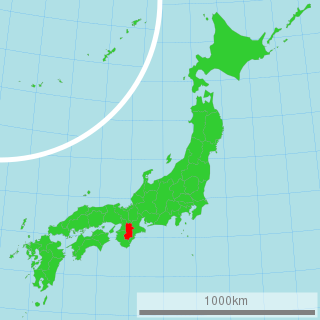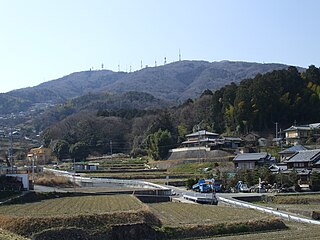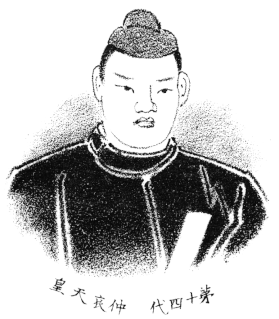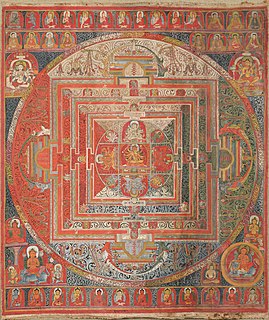
A Shinto shrine is a structure whose main purpose is to house ("enshrine") one or more kami. Its most important building is used for the safekeeping of sacred objects, and not for worship. Although only one word ("shrine") is used in English, in Japanese Shinto shrines may carry any one of many different, non-equivalent names like gongen, -gū, jinja, jingū, mori, myōjin, -sha, taisha, ubusuna or yashiro.

Hirota Shrine is a Shinto shrine in Nishinomiya City, Hyōgo Prefecture, Japan. The town's name, "Nishinomiya", means "shrine of the west", and the town is named for Hirota Shrine.
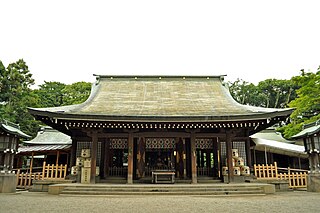
Hikawa Shrine is a Japanese Shinto shrine in Omiya-ku, Saitama, Saitama Prefecture. Surrounding the shrine is a large park in which there are many cherry blossom trees, a zoo and a museum.
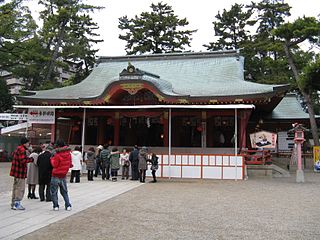
Nagata Shrine is a Shinto shrine in Nagata-ku, Kobe, Japan. At Nagata, Kotoshironushi-no-Okami is enshrined.

Shizuoka Sengen Jinja (静岡浅間神社) is the name for a collective group of three Shinto shrines now forming a single religious corporation, located at Mount Shizuhata in Aoi-ku, Shizuoka, in Shizuoka Prefecture, Japan. These shrines are the Kanbe Jinja (神部神社), Sengen Jinja (浅間神社), and Ōtoshimioya Jinja (大歳御祖神社). The main festival of the shrine is held annually on April 5.

An Asama shrine is a type of Shinto Shrine in Japan centered on the worship of the kami of volcanos in general, and Mount Fuji in particular.

A kannushi(神主, "god master", originally pronounced kamunushi), also called shinshoku, is the person responsible for the maintenance of a Shinto shrine as well as for leading worship of a given kami. The characters for kannushi are sometimes also read jinshu with the same meaning.

The Hokkaidō Shrine is a Shinto shrine located in Sapporo, Hokkaido, Japan. Sited in Maruyama Park, Chūō-ku, Sapporo, Hokkaido, the Hokkaido Shrine enshrines four kami including the soul of the Emperor Meiji. A number of early explorers of Hokkaidō such as Mamiya Rinzō are also enshrined.
Sumiyoshi sanjin (住吉三神) is the generic name for the three Shinto gods Sokotsutsu no O no Mikoto (底筒男命), Nakatsutsu no O no Mikoto (中筒男命), and Uwatsutsu no O no Mikoto (表筒男命). The Sumiyoshi sanjin are regarded as the gods of the sea and sailing. They are sometimes referred to as the Sumiyoshi daijin (住吉大神).
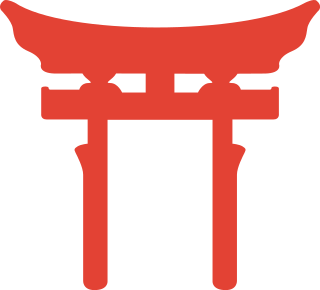
This is the glossary of Shinto, including major terms the casual reader might find useful in understanding articles on the subject. Words followed by an asterisk (*) are illustrated by an image in one of the photo galleries. Within definitions, words set in boldface are defined elsewhere in the glossary.

Ōmiwa Shrine, also known as Miwa Shrine, is a Shinto shrine located in Sakurai, Nara, Japan. The shrine is noted because it contains no sacred images or objects because it is believed to serve Mount Miwa, the mountain on which it stands. For the same reason, it has a worship hall, but no place for the deity to be housed. In this sense, it is a model of what the first Shinto shrines were like. Ōmiwa Shrine is one of the oldest extant Shinto shrines in Japan and the site has been sacred ground for some of the earliest religious practices in Japan. Because of this, it has sometimes been named as Japan's first shrine. Ōmiwa Shrine is a tutelary shrine of the Japanese sake brewers.
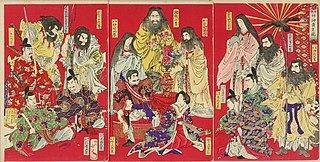
The modern system of ranked Shinto shrines was an organizational aspect of the establishment of Japanese State Shinto. This system classified Shinto shrines as either official government shrines or "other" shrines. The official shrines were divided into
- Imperial shrines (kampeisha), which are parsed into minor, medium, or major sub-categories; and
- National shrines (kokuheisha), which are similarly categorized as minor, medium, or major.

The Awa Shrine is a Shinto shrine in the city of Tateyama in Chiba Prefecture, Japan. It is one of two shrines claiming to hold the title of ichinomiya of former Awa Province. The main festival of the shrine is held annually on August 10.

Sarutahiko Ōkami, is the leader of the earthly kami, deity of the Japanese religion of Shinto. Norito also mentions him with the title Daimyōjin instead of Ōkami.

In Japan, a chinjusha is a Shinto shrine which enshrines a tutelary kami; that is, a patron spirit that protects a given area, village, building or a Buddhist temple. The Imperial Palace has its own tutelary shrine dedicated to the 21 guardian gods of Ise Shrine. Tutelary shrines are usually very small, but there is a range in size, and the great Hiyoshi Taisha for example is Enryaku-ji's tutelary shrine. The tutelary shrine of a temple or the complex the two together form are sometimes called a temple-shrine. If a tutelary shrine is called chinju-dō, it is the tutelary shrine of a Buddhist temple. Even in that case, however, the shrine retains its distinctive architecture.

Tosa jinja (土佐神社), also known as Tosa nimasu jinja,Tosa takakamo Taisha, is a Shinto shrine located in the west of Kōchi in Kōchi Prefecture in Japan.

Kehi Shrine is a Shinto shrine in the city of Tsuruga, Fukui Prefecture, Japan. In the former Modern system of ranked Shinto Shrines, it was a national shrine of the 1st rank, and the ichinomiya of Echizen Province. Its main festival is held annually on September 4. The shrine is considered the chief guardian shrine of the Hokuriku region.

Yoshino Shrine is a Shinto shrine located in Yoshino, Yoshino District, Nara Prefecture, Japan. Prefecture, Japan. It was founded in 1892. The main kami enshrined here is Emperor Go-Daigo. The shrine's main festival is held annually on September 27. It was formerly an imperial shrine of the first rank in the Modern system of ranked Shinto Shrines.

Kamayama Shrine is a Shinto shrine in Wakayama, Wakayama Prefecture, Japan. It was formerly an imperial shrine of the first rank in the Modern system of ranked Shinto Shrines. The main kami enshrined here is Hikoisetsu no mikoto / Itsuse no Mikoto (彦五瀬命) eldest son of Ugayafukiaezu and older brother of Emperor Jimmu.

Gassan Shrine is a Shinto shrine on Mount Gassan in Yamagata Prefecture, Japan. It was formerly a national shrine of the first rank in the Modern system of ranked Shinto Shrines. The main kami enshrined here is Tsukuyomi-no-Mikoto. It was established in 593.


